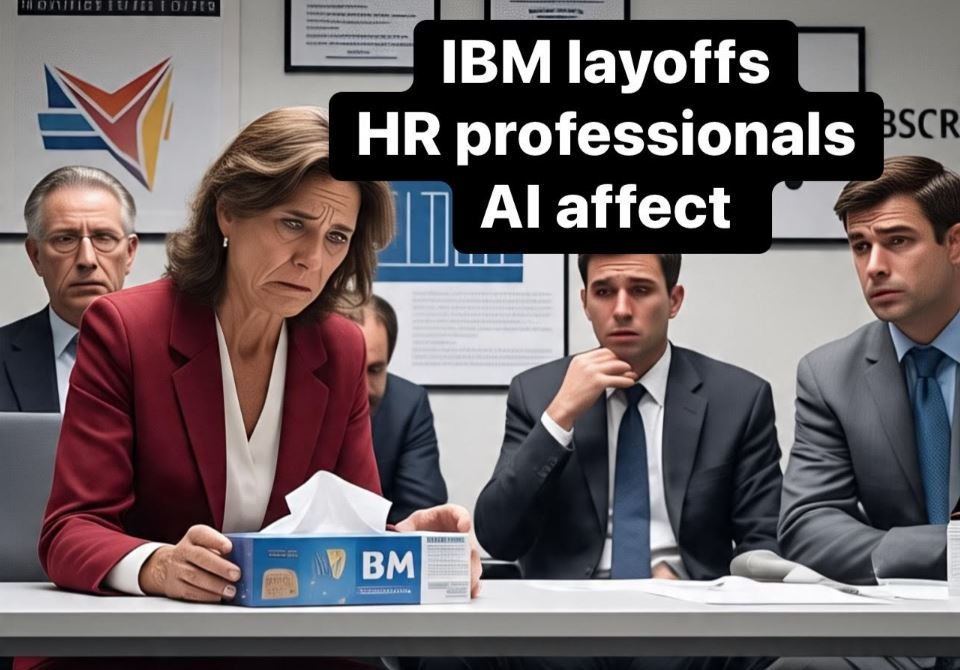IBM Layoffs due to the excellent trend of AI modules and In a bold and sweeping move, IBM has laid off approximately 8,000 employees from its Human Resources (HR) departments globally. This significant workforce reduction has triggered intense discussions across corporate corridors, technology communities, and labor forums. The restructuring is part of IBM’s strategic shift toward automation, artificial intelligence (AI), and cost optimization—a change that signals a broader trend reshaping how businesses handle workforce management.
Key Takeaways
- IBM has terminated around 8,000 HR roles worldwide as part of its digital transformation strategy.
- The company cites increased reliance on AI and automation tools like Watsonx as a reason for the layoffs.
- The move raises ethical and operational questions about the future role of HR in corporate settings.
- It highlights a growing divide between traditional HR functions and AI-powered workforce management.
- Competitors and mid-sized firms are closely watching IBM’s transition to draw their own digital strategies.

Understanding the Layoffs: A Breakdown
The layoffs at IBM primarily affect employees within the Human Resources sector, particularly in roles associated with talent acquisition, onboarding, training, and performance management. IBM’s leadership, including CEO Arvind Krishna, stated that the company is shifting its focus toward a tech-first HR model powered by AI-driven platforms such as Watsonx, IBM’s flagship AI suite.
Affected employees span various regions, including North America, Europe, and parts of Asia-Pacific. According to internal reports, IBM is investing heavily in automating repetitive HR tasks, such as resume screening, payroll processing, and employee engagement surveys.
Why HR Was Targeted
While many companies tend to reduce costs through cutting operations or support departments, IBM’s decision to focus on HR is deliberate. HR Jobs in USA and functions are often perceived as ripe for automation because of their process-driven nature. Here’s why HR was on the chopping block:
- Redundancy through AI Tools: IBM has developed AI solutions that can perform many HR tasks faster, cheaper, and with fewer errors.
- Digital-First Culture: IBM’s pivot to a fully digital, cloud-centric model requires fewer administrative layers.
- Global Restructuring: A broader cost-cutting initiative aims to align operations with post-pandemic hybrid work realities.
- Merger & Acquisitions Realignment: IBM’s divestitures (such as Kyndryl) required a leaner HR structure.
The Role of AI and Watsonx in HR Automation
At the heart of IBM’s restructuring is Watsonx, an advanced AI platform designed for enterprise-level automation and decision-making. Watsonx is being used to:
- Automate resume screening using natural language processing.
- Generate employee performance reports through data analytics.
- Predict attrition rates and recommend retention strategies.
- Customize learning and development plans using AI.
IBM Layoffs and AI trend watsonx This not only improves efficiency but also significantly reduces costs associated with manual HR processes.
The Ethical Dilemma: AI vs. Human Touch
IBM’s decision has sparked debates around ethics, workforce morale, and the human aspect of HR. Critics argue that no machine can replicate the empathy, emotional intelligence, and nuanced decision-making that human HR professionals bring to sensitive matters like workplace disputes or employee grievances.
Others defend IBM’s move as a necessary evolution, where humans must move up the value chain while machines handle repetitive tasks. The debate is no longer about if AI will replace jobs—but how many and how quickly.
Global Reactions and Employee Sentiment
The reaction has been mixed across IBM’s global workforce. In North America and Europe, labor unions have expressed concerns, demanding greater transparency and support for laid-off workers. Some employees have taken to platforms like LinkedIn and Glassdoor to share their experiences, expressing disappointment but also acknowledging the inevitability of automation.
IBM Layoffs in various countries and markets like India and the Philippines, where IBM has large service delivery hubs, the news has caused anxiety among HR contractors and third-party staffing agencies.
Business Strategy Behind the Move
IBM Layoffs are not isolated; they’re part of a broader transformation agenda:
- Cloud and AI Leadership: IBM wants to dominate enterprise AI by leading through example.
- Cost Reduction: The layoffs are expected to save IBM around $500 million annually.
- Lean Operations: A flatter hierarchy helps IBM respond faster to market demands.
- Reinvestment into R&D: Resources saved from HR will be redirected to developing AI, cybersecurity, and quantum computing technologies.

Competitors React: Will Others Follow?
Other tech giants like Google, Microsoft, and Amazon are closely observing IBM’s transition. Microsoft has already embedded AI into its HR processes via Dynamics 365. Google is using internal tools to automate candidate matching. IBM’s drastic step could trigger a domino effect across the industry, especially in large enterprises with bloated support functions.
ibm news layoffs and As per the strategies of IBM Layoffs various Mid-sized companies may also see this as a sign to rethink their HR investments and prioritize scalable, digital-first hiring solutions.
Impact on the Future of HR Jobs
The HR profession is undoubtedly being reshaped. Traditional HR roles that rely on administrative tasks will continue to decline, while strategic HR positions, such as organizational development, change management, and employee experience, will become more crucial.
The future HR landscape will likely include:
- AI specialists in HR departments to manage and fine-tune automation tools.
- Behavioral scientists and data analysts for workforce analytics.
- Experience designers focused on employee engagement and retention.
- Compliance officers to oversee ethical AI usage and prevent bias in HR algorithms.
Legal and Regulatory Backlash
IBM may face scrutiny from regulators in certain jurisdictions. The European Union, for instance, enforces stringent data privacy and employee rights laws. Automating HR decisions without human oversight could violate the General Data Protection Regulation (GDPR), especially if AI decisions lead to discriminatory practices.
Labor unions in Germany and France have already voiced concerns, and watchdogs may require IBM to conduct impact assessments of its AI tools on employment.
IBM’s Response and Severance Policies
IBM Layoffs and IBM has assured that all affected employees will receive severance packages, access to career counseling, and early retirement options where applicable. The company has also created internal retraining pathways for those interested in moving to AI-related roles.
Despite these efforts, the scale of the layoff makes it one of the largest HR-specific job cuts in corporate history.
Lessons for Other Enterprises
Businesses planning similar transitions must tread carefully. Here’s what other companies can learn:
- Communicate Transparently: Uncertainty can harm morale.
- Invest in Reskilling: Equip current employees with future-ready skills.
- Phase the Transition: Sudden changes lead to backlash and disruption.
- Ensure Ethical AI Practices: Biased algorithms can cause long-term reputational damage.
- Maintain a Human Core: Machines can’t replace empathy, culture-building, or leadership.
Employee Advocacy and the Rise of Tech Unions
IBM’s move may also accelerate the growth of employee advocacy networks and tech unions. IBM Layoffs in very large geographical area also While historically tech workers have not been heavily unionized, mass layoffs—especially in perceived “safe” departments like HR—are pushing workers to organize.
This could lead to:
- Stronger collective bargaining agreements.
- AI usage oversight committees.
- Legal mandates for ethical HR automation.
What’s Next for IBM?
IBM plans to expand Watsonx to non-HR domains including supply chain, legal, and customer service. IBM Layoffs and the current restructuring is expected to conclude by Q3 2025. Future workforce investments will be directed toward AI governance, machine learning engineers, and enterprise transformation consultants.
IBM is also expected to release its AI Human Capital Efficiency Index later this year, a benchmarking tool for businesses looking to gauge their AI-readiness in workforce management.
Conclusion
IBM’s layoff of 8,000 HR employees is more than a cost-cutting measure; it’s a signal of how deeply AI will penetrate every layer of modern enterprises. As companies race toward digital transformation, the HR function as we know it is being redefined—from a people-centric department to a data-augmented strategic unit.
The move is not without consequences, but it lays the foundation for a new corporate operating model—leaner, faster, and powered by machine intelligence.
FAQs
Why did IBM lay off 8,000 HR employees?
IBM laid off 8,000 HR employees to streamline operations, reduce costs, and accelerate its shift toward AI-powered workforce management through its Watsonx platform.
What will happen to the roles previously handled by HR staff?
Many tasks previously performed by HR employees—like resume screening, payroll, and employee analytics—are now automated using AI. Strategic roles may still require human oversight.
Will this affect IBM’s reputation as an employer?
While some backlash is inevitable, IBM’s commitment to retraining and ethical AI use may help mitigate long-term reputational risks.
Can other companies follow IBM’s path?
Yes, especially large enterprises with tech infrastructure in place. However, smaller firms may need to weigh cost, risk, and cultural impacts before adopting similar automation strategies.
Are HR jobs at risk in general?
Administrative HR roles are increasingly vulnerable to automation, but strategic, empathetic, and ethical aspects of HR are still in demand and evolving.
